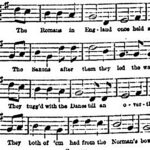22 October 1906: The Yorkshire Herald reports that the king of the Wensleydale dry-stone wallers has discovered a devil among the stones
Yorkshire Herald. 1906/11/24. The Fairy Stone. Notes and Queries. London: Macmillan and Co. Get it:
.Excerpt
He was working at a gap in a wall which had so often needed repairs in the same spot that popular opinion had pronounced “t’ deevil’s in the lile bit o’ wall.” “It’s been down,” declared the artist, “nobbut a dussin times it’ yeear, an’ nane on em can mak ‘t stand. If it win’t haud efter me, then it isn’t i’ men et dry-walls ti mak ‘t stand… Naay, thur’s nae fawt i’ t’ steans; but it mun be t’ waay t’ thrufs been laid. Hy’e that ‘s it – it ‘s t’ thrufs – if it tummels efter me, then thur ‘s nae dowt thur ‘s sumat unnateral abowt it.” The next day I found myself on the same spot, but when my old friend espied me over the wall he shouted with all the force of his mountain-air-primed lungs: “Ah ‘ve fun’t it, ah ‘ve fun’t! Fules! How cud t’ wall stan’ wi’ a fairy-stean in ‘t?” and he held up a long rounded stone, a splendidly weathered encrinite, which I at once appropriated. “Now yer ‘ll see t’ wall ‘l stand reet eneugh!” The next few weeks will test the point whether t’ deevel amang t’ steans has been removed.
Comment
Comment
Via Beach Combing.
More Wensleydale satanism in Richard Brathwait’s Drunken Barnaby:
Thence to Wenchly, valley-seated,
For antiquity repeated:
Sheep and shepherd, as one brother,
Kindly drink to one another;
Till pot-hardy, light as feather,
Sheep and shepherd sleep together.
(Brathwait 1762)
Something to say? Get in touch
Original
A correspondent of The Yorkshire Herald, 22 October, gives an account of a recent interview with an aged man whom he calls the king of dry stone-wallers in Wensleydale. He was working at a gap in a wall which had so often needed repairs in the same spot that popular opinion had pronounced “t’ deevil’s in the lile bit o’ wall.”
“It’s been down,” declared the artist,
nobbut a dussin times it’ yeear, an’ nane on em can mak ‘t stand. If it win’t haud efter me, then it isn’t i’ men et dry-walls ti mak ‘t stand… Naay, thur’s nae fawt i’ t’ steans; but it mun be t’ waay t’ thrufs been laid. Hy’e that ‘s it – it ‘s t’ thrufs – if it tummels efter me, then thur ‘s nae dowt thur ‘s sumat unnateral abowt it.
“The next day,” says the narrator,
I found myself on the same spot, but when my old friend espied me over the wall he shouted with all the force of his mountain-air-primed lungs: “Ah ‘ve fun’t it, ah ‘ve fun’t! Fules! How cud t’ wall stan’ wi’ a fairy-stean in ‘t?” and he held up a long rounded stone, a splendidly weathered encrinite, which I at once appropriated. “Now yer ‘ll see t’ wall ‘l stand reet eneugh!” The next few weeks will test the point whether t’ deevel amang t’ steans has been removed.
257 words.
Similar
Search
Donate
Music & books
Place-People-Play: Childcare (and the Kazookestra) on the Headingley/Weetwood borders next to Meanwood Park.
Music from and about Yorkshire by Leeds's Singing Organ-Grinder.



 Bluesky
Bluesky Extwitter
Extwitter